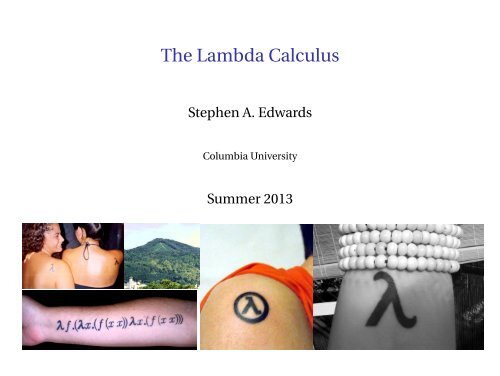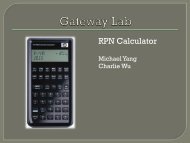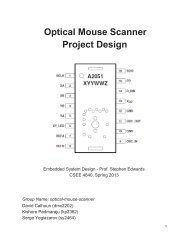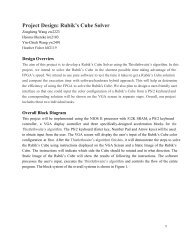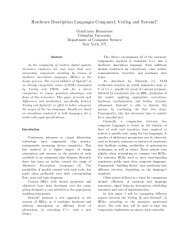The Lambda Calculus - Columbia University
The Lambda Calculus - Columbia University
The Lambda Calculus - Columbia University
Create successful ePaper yourself
Turn your PDF publications into a flip-book with our unique Google optimized e-Paper software.
<strong>The</strong> <strong>Lambda</strong> <strong>Calculus</strong>Stephen A. Edwards<strong>Columbia</strong> <strong>University</strong>Summer 2013
<strong>Lambda</strong> ExpressionsFunction application written in prefix form. “Add four and five” is(+ 4 5)Evaluation: select a redex and evaluate it:(+ (∗ 5 6) (∗ 8 3)) → (+ 30 (∗ 8 3))→ (+ 30 24)→ 54Often more than one way to proceed:(+ (∗ 5 6) (∗ 8 3)) → (+ (∗ 5 6) 24)→ (+ 30 24)→ 54Simon Peyton Jones, <strong>The</strong> Implementation of Functional Programming Languages,Prentice-Hall, 1987.
Function Application and CurryingFunction application is written as juxtaposition:f xEvery function has exactly one argument. Multiple-argumentfunctions, e.g., +, are represented by currying, named after HaskellBrooks Curry (1900–1982). So,(+ x)is the function that adds x to its argument.Function application associates left-to-right:(+ 3 4) = ((+ 3) 4)→ 7
<strong>Lambda</strong> Abstraction<strong>The</strong> only other thing in the lambda calculus is lambda abstraction:a notation for defining unnamed functions.(λx . + x 1)( λ x . + x 1 )↑ ↑ ↑ ↑ ↑ ↑That function of x that adds x to 1
<strong>The</strong> Syntax of the <strong>Lambda</strong> <strong>Calculus</strong>expr ::= expr expr| λ variable . expr| constant| variable| (expr)Constants are numbers and built-in functions;variables are identifiers.Function application binds more tightly than λ:λx.f g x = ( λx.(f g )x )
Beta-ReductionEvaluation of a lambda abstraction—beta-reduction—is justsubstitution:(λx . + x 1) 4 → (+ 4 1)→ 5<strong>The</strong> argument may appear more than once(λx . + x x) 4 → (+ 4 4)→ 8or not at all(λx . 3) 5 → 3
Beta-ReductionFussy, but mechanical. Extra parentheses may help.( ( ((λx . λy . + x y) 3 4 = λx . λy . ( (+ x) y ))) )3 4(→ λy . ( (+ 3) y ) )4( )→(+ 3) 4→ 7Functions may be arguments(λf . f 3) (λx . + x 1) → (λx . + x 1) 3→ (+ 3 1)→ 4
Free and Bound Variables(λx . + x y) 4Here, x is like a function argument but y is like a global variable.Technically, x occurs bound and y occurs free in(λx . + x y)However, both x and y occur free in(+ x y)
Beta-Reduction More Formally(λx . E) F → β E ′where E ′ is obtained from E by replacing every instance of x thatappears free in E with F .<strong>The</strong> definition of free and bound mean variables have scopes. Onlythe rightmost x appears free in(λx . + (− x 1)) x 3so(λx . (λx . + (− x 1)) x 3) 9 → (λ x . + (− x 1)) 9 3→ + (− 9 1) 3→ + 8 3→ 11
Another Example(λx . λy . + x ( (λx . − x 3) y )) (5 6 → λy . + 5 ( (λx . − x 3) y )) 6→ + 5 ( (λx . − x 3) 6 )→ + 5 (− 6 3)→ + 5 3→ 8
Alpha-ConversionOne way to confuse yourself less is to do α-conversion: renaming aλ argument and its bound variables.Formal parameters are only names: they are correct if they areconsistent.(λx . (λx . + (− x 1)) x 3) 9 ↔ (λx . (λy . + (− y 1)) x 3) 9→ ((λy . + (− y 1)) 9 3)→ (+ (− 9 1) 3)→ (+ 8 3)→ 11You’ve probably done this before in C or Java:int add(int x, int y){return x + y;}↔int add(int a, int b){return a + b;}
Reduction Order<strong>The</strong> order in which you reduce things can matter.(λx . λy . y) ( (λz . z z) (λz . z z) )Two things can be reduced:(λz . z z) (λz . z z)(λx . λy . y) ( ··· )However,(λz . z z) (λz . z z) → (λz . z z) (λz . z z)(λx . λy . y) ( ··· ) → (λy . y)
Normal FormA lambda expression that cannot be β-reduced is in normal form.Thus,λy . yis the normal form of(λx . λy . y) ( (λz . z z) (λz . z z) )Not everything has a normal form. E.g.,(λz . z z) (λz . z z)can only be reduced to itself, so it never produces an non-reducibleexpression.
Normal FormCan a lambda expression have more than one normal form?Church-Rosser <strong>The</strong>orem I: If E 1 ↔ E 2 , then there existsan expression E such that E 1 → E and E 2 → E.Corollary. No expression may have two distinct normal forms.Proof. Assume E 1 and E 2 are distinct normal forms for E: E ↔ E 1and E ↔ E 2 . So E 1 ↔ E 2 and by the Church-Rosser <strong>The</strong>orem I, theremust exist an F such that E 1 → F and E 2 → F . However, since E 1and E 2 are in normal form, E 1 = F = E 2 , a contradiction.
Normal-Order ReductionNot all expressions have normal forms, but is there a reliable way tofind the normal form if it exists?Church-Rosser <strong>The</strong>orem II: If E 1 → E 2 and E 2 is in normal form,then there exists a normal order reduction sequence from E 1 to E 2 .Normal order reduction: reduce the leftmost outermost redex.
Normal-Order Reduction( (λx . ( (λw . λz . + w z) 1 )) ((λx . x x) (λx . x x)) ) ((λy . + y 1) (+ 2 3))leftmost outermostleftmost innermostλxλxλxλy3λw 1λz+ w zxxxx1 + 2+ y
Boolean Logic in the <strong>Lambda</strong> <strong>Calculus</strong>“Church Booleans”true = λx . λy . xfalse = λx . λy . yEach is a function of two arguments: true is “select first;” false is“select second.” If-then-else uses its predicate to select then or else:ifelse = λp . λa . λb . p a bE.g.,ifelse true 42 58 = true 42 58→ (λx . λy . x) 42 58→ (λy . 42) 58→ 42
Boolean Logic in the <strong>Lambda</strong> <strong>Calculus</strong>Logic operators can be expressed with if-then-else:and = λp . λq . p q por = λp . λq . p p qnot = λp . λa . λb . p b aand true false = (λp . λq . p q p) true false→ true false true→ (λx . λy . x) false true→ falsenot true = (λp . λa . λb . p b a) true→ β λa . λb . true b a→ β λa . λb . b→ α λx . λy . y= false
Arithmetic: <strong>The</strong> Church Numerals0 = λf . λx . x1 = λf . λx . f x2 = λf . λx . f (f x)3 = λf . λx . f ( f (f x) )I.e., for n = 0,1,2,..., n f x = f (n) (x). <strong>The</strong> successor function:succ = λn . λf . λx . f (n f x)succ 2 = ( λn . λf . λx . f (n f x) ) 2→ λf . λx . f (2 f x)( (λf ) )= λf . λx . f . λx . f (f x) f x→ λf . λx . f ( f (f x) )= 3
Adding Church NumeralsFinally, we can add:plus = λm.λn.λf .λx. m f ( n f x)plus 3 2 = ( λm.λn.λf .λx. m f ( n f x) ) 3 2→ λf .λx. 3 f ( 2 f x)→ λf .λx. f (f (f (2 f x)))→ λf .λx. f (f (f (f ( f x))))= 5Not surprising since f (m) ◦ f (n) = f (m+n)
Multiplying Church Numeralsmult = λm.λn.λf .m (n f )mult 2 3 = ( λm.λn.λf .m (n f ) ) 2 3→ λf .2 (3 f )= λf . 2 (λx. f (f (f x)))↔ α λf . 2 (λy. f (f (f y)))→ λf . λx. (λy. f (f (f y))) ((λy. f (f (f y))) x)→ λf . λx. (λy. f (f (f y))) (f (f (f x)))→ λf . λx. f (f (f (f (f (f x))) ))= 6<strong>The</strong> predecessor function is trickier since there aren’t negativenumbers.
RecursionWhere is recursion in the lambda calculus?(fac = λn . if (= n 0) 1(∗ n ( fac (− n 1) )))This does not work: functions are unnamed in the lambda calculus.But it is possible to express recursion as a function.fac = (λn . ... fac ...)← β (λf . (λn . ... f ...)) fac= H facThat is, the factorial function, fac, is a fixed point of the(non-recursive) function H:H = λf . λn . if (= n 0) 1 (∗ n (f (− n 1)))
RecursionLet’s invent a function Y that computes fac from H, i.e., fac = Y H:fac = H facY H = H (Y H)fac 1 = Y H 1= H (Y H) 1= (λf . λn . if (= n 0) 1 (∗ n (f (− n 1)))) (Y H) 1→ (λn . if (= n 0) 1 (∗ n ((Y H) (− n 1)))) 1→ if (= 1 0) 1 (∗ 1 ((Y H) (− 1 1)))→ ∗ 1 (Y H 0)= ∗ 1 (H (Y H) 0)= ∗ 1 ((λf . λn . if (= n 0) 1 (∗ n (f (− n 1)))) (Y H) 0)→ ∗ 1 ((λn . if (= n 0) 1 (∗ n (Y H (− n 1)))) 0)→ ∗ 1 (if (= 0 0) 1 (∗ 0 (Y H (− 0 1))))→ ∗ 1 1→ 1
<strong>The</strong> Y CombinatorHere’s the eye-popping part: Y can be a simple lambda expression.Y == λf . ( λx . f (x x) ) ( λx . f (x x) )(Y H = λf . ( λx . f (x x) ) ( λx . f (x x) )) H→ ( λx . H (x x) ) ( λx . H (x x) )( (λx ) ( ) ). H (x x) λx . H (x x)→ H↔ H( (λf . ( λx . f (x x) ) ( λx . f (x x) )) )H= H (Y H)“Y: <strong>The</strong> function that takes a function f and returns f (f (f (f (···))))”
Alonzo Church1903–1995Professor at Princeton (1929–1967)and UCLA (1967–1990)Invented the <strong>Lambda</strong> <strong>Calculus</strong>Had a few successful graduate students, including▶ Stephen Kleene (Regular expressions)▶ Michael O. Rabin † (Nondeterministic automata)▶ Dana Scott † (Formal programming language semantics)▶ Alan Turing (Turing machines)† Turing award winners
Turing Machines vs. <strong>Lambda</strong> <strong>Calculus</strong>In 1936,▶ Alan Turing invented the Turingmachine▶ Alonzo Church invented thelambda calculusIn 1937, Turing proved that the two models were equivalent, i.e.,that they define the same class of computable functions.Modern processors are just overblown Turing machines.Functional languages are just the lambda calculus with a morepalatable syntax.


